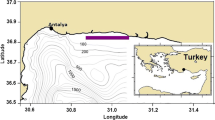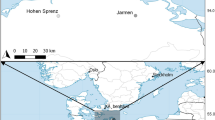Abstract
The temporal prevalence of the widespread boring sponge Cliona celata and its effects were analysed in a population of the invasive mollusc Crepidula fornicata. This mollusc produces extra shell material when infested with the endolithic sponge, suggesting that infestation may be detrimental for C. fornicata growth and/or reproduction. For 37 months, size, sex, female reproductive status and sponge-infestation stage were recorded for 300 individuals sampled every month in the Bay of Morlaix (France). In the 12,049 individuals examined, the prevalence of C. celata was high with a monthly average of 43.1% of the individuals hosting the sponge. The relative proportion of heavily infested individuals generally increased over time. Nevertheless, a cyclic decrease occurred every 10 months, suggesting putative episodes of mortality of heavily infested individuals. The gregarious behaviour of the mollusc seemed to promote the high prevalence of the sponge, which may propagate through contact between neighbouring C. fornicata individuals. Due to the sex-size relationship in protandrous C. fornicata, females were far more infested than males. We did not find evidence for a cost of producing extra shell material on somatic growth or on female fertility, and the boring sponge is unlikely to substantially affect the sex-change patterns in C. fornicata. The limited effects of the endolithic sponge on C. fornicata contrasts with the documented damage to some local species, including commercially exploited shellfish, suggesting that C. fornicata may alter the infestation dynamics in the surrounding native community. Dedicated studies are now needed to investigate the extent and mechanisms of these species interactions.




Similar content being viewed by others
References
Barucca M, Azzini F, Bavestrello G, Biscotti M, Calcinai B, Canapa A, Cerrano C, Olmo E (2007) The systematic position of some boring sponges (Demospongiae, Hadromerida) studied by molecular analysis. Mar Biol 151:529–535. doi:10.1007/s00227-006-0486-y
Blanchard M (1995) Origin and present state of the slipper limpet (Crepidula fornicata) population, (Gastropoda Prosobranchia) on French coasts. Haliotis 24:75–86
Blanchard M (1997) Spread of the slipper limpet Crepidula fornicata (L.1758) in Europe. Current state and consequences. Sci Mar 61:109–118
Brante A, Fernàndez M, Viard F (2008) Effect of oxygen conditions on intracapsular development in two calyptraeid species with different modes of larval development. Mar Ecol Prog Ser 368:197–207. doi:10.3354/meps07605
Buschbaum C, Buschbaum G, Schrey I, Thieltges DW (2007) Shell-boring polychaetes affect gastropod shell strength and crab predation. Mar Ecol Prog Ser 329:123–130. doi:10.3354/meps329123
Charnov EL (1982) The theory of sex allocation. Princeton university press, New Jersey
Chipperfield PNJ (1951) The breeding of Crepidula fornicata in the River Blackwater, Essex. J Mar Biol Assoc UK 30:49–71
Clavier J (1989) Infestation of Haliotis tuberculata shells by Cliona celata and Polydora species. In: Guzman del Proo SA, Tegner MJ, Shepherd SA (eds) Abalone of the world: biology, fisheries and culture supplementary papers, pp 16–20, La Paz
Coe WR (1938) Conditions influencing change of sex in mollusks of the genus Crepidula. J Exp Zool 77:401–424
Colautti RI, Ricciardi A, Grigorovich IA, MacIsaac HJ (2004) Is invasion success explained by the enemy release hypothesis? Ecol Lett 7:721–733. doi:10.1111/j.1461-0248.2004.00616.x
Collin R (1995) Sex, size and position: a test of models predicting size at sex change in the protandrous gastropod Crepidula fornicata. Am Nat 146:815–831. doi:10.1086/285826
Collin R (2006) Sex ratio, life-history invariants, and patterns of sex change in a family of protandrous gastropods. Evolution 60:735–745. doi:10.1111/j.0014-3820.2006.tb01152.x
Conklin EG (1898) Environmental and sexual dimorphism in Crepidula. Proc Acad Nat Sci Philadelphia 50:435–444
De Montaudouin X, Sauriau PG (1999) The proliferating Gastropoda Crepidula fornicata may stimulate macrozoobenthic diversity. J Mar Biol Assoc UK 79:1069–1077. doi:10.1017/S0025315499001319
Diaz MC, Rützler K (2001) Sponges: an essential component of Caribbean coral reefs. Bull Mar Sci 69:535–546
Dunn AM (2009) Parasites and biological invasions. Advances in parasitology, vol 68. Elsevier Academic Press Inc, San Diego, pp 161–184. doi:10.1016/S0065-308X(08)00607-6
Dupont L, Richard J, Paulet YM, Thouzeau G, Viard F (2006) Gregariousness and protandry promote reproductive insurance in the invasive gastropod Crepidula fornicata: evidence from assignment of larval paternity. Mol Ecol 15:3009–3021. doi:10.1111/j.1365-294X.2006.02988.x
Dupont L, Bernas D, Viard F (2007) Sex and genetic structure across age groups in populations of the European marine invasive mollusc, Crepidula fornicata L. (Gastropoda). Biol J Linnean Soc 90:365–374. doi:10.1111/j.1095-8312.2007.00731.x
Evans JW (1969) Borers in the shell of the sea scallop, Placopecten magellnnicus. Am Zool 9:775–782. doi:10.1093/icb/9.3.775
Fromont J, Craig R, Rawlinson L, Alder J (2005) Excavating sponges that are destructive to farmed pearl oysters in Western and Northern Australia. Aquac Res 36:150–162. doi:10.1111/j.1365-2109.2004.01198.x
Ghiselin MT (1969) The evolution of hermaphroditism among animals. Q Rev Biol 44
Guida VG (1976) Sponge predation in the oyster reef community as demonstrated with Cliona celata Grant. J Exp Mar Biol Ecol 25:109–122. doi:10.1016/0022-0981(76)90012-5
Gutiérrez JL, Jones CG, Strayer DL, Iribarne OO (2003) Mollusks as ecosystem engineers: the role of shell production in aquatic habitats. Oikos 101:79–90. doi:10.1034/j.1600-0706.2003.12322.x
Hart AM, Friedman KJ (2004) Mother-of-pearl shell (Pinctada maxima): stock evaluation for management and future harvesting in Western Australia. Fisheries research contract report. WA Marine Research Laboratories, North Beach
Hartman WD (1957) Ecological niche differentiation in the boring sponges (Clionidae). Evolution. 11:294–297
Hartman WD (1958) Natural history of the marine sponges of the Southern New England. Bull Peabody Mus Nat Hist 12:1–155
Hoagland KE (1978) Protandry and the evolution of environmentally-mediated sex change: a study of the Mollusca. Malacologia 17:365–391
Hoeksema BW (1983) Excavating patterns and spiculae dimensions of the boring sponge Cliona celata from SW Netherlands. Senck marit 15:55–85
Huchette S, Paillard C, Clavier J, Day R (2006) Shell disease: abnormal conchiolin deposit in the abalone Haliotis tuberculata. Dis Aquat Org 68:267–271. doi:10.3354/dao068267
Kelly DW, Paterson RA, Townsend CR, Poulin R, Tompkins DM (2009) Parasite spillback: a neglected concept in invasion ecology? Ecology 90:2047–2056. doi:10.1890/08-1085.1
Le Cam, S. (2009). Gregarité, changement de sexe et polyandrie: modalites de la reproduction chez une espèce invasive Crepidula fornicata. Thèse de doctorat, Université Pierre et Marie Curie-Paris 6, Paris
Le Cam S, Pechenik JA, Cagnon M, Viard F (2009) Fast vs. slow larval growth in an invasive marine mollusc: does paternity matter? J Hered 100: 455–464. doi: 10.1093/jhered/esp007
Le Pape O, Guérault D, Désaunay Y (2004) Effect of an invasive mollusc, American slipper limpet Crepidula fornicata, on habitat suitability for juvenile common sole Solea solea in the Bay of Biscay. Mar Ecol Prog Ser 277:107–115. doi:10.3354/meps277107
Lévi C (1950) Inventaire de la faune marine de Roscoff–Spongiaires-Suppl 2. Travaux de la Station Biologique de Roscoff, Roscoff
Mariani S, Uriz MJ, Turon X (2000) Larval bloom of the oviparous sponge Cliona viridis: coupling of larval abundance and adult distribution. Mar Biol 137:783–790. doi:10.1007/s002270000400
Marin MG, Moschino V, Meneghetti F, Da Ros L (2005) Effects of mechanical stress in under-sized clams, Tapes philippinarum: a laboratory approach. Aquacult Int 13:75–88. doi:10.1007/s10499-004-9029-z
McEdward LR, Coulter LK (1987) Egg volume and energetic content are not correlated among sibling offspring of starfish: implications for life-history theory. Evolution 41:914–917
Molnar JL, Gamboa RL, Revenga C, Spalding MD (2008) Assessing the global threat of invasive species to marine biodiversity. Front Ecol Environ 6(9):485–492. doi:10.1890/070064
Palmer AR (1992) Calcification in marine molluscs: how costly is it? Proc Natl Acad Sci U S A 89:1379–1382
Pomponi SA (1980) Cytological mechanisms of calcium carbonate excavation by boring sponges. Int Rev Cytol 65:301–319
Richard J, Huet M, Thouzeau G, Paulet YM (2006) Reproduction of the invasive slipper limpet, Crepidula fornicata, in the bay of Brest, France. Mar Biol 149:789–801. doi:10.1007/s00227-005-0157-4
Rosell D, Uriz MJ, Martin D (1999) Infestation by excavating sponges on the oyster (Ostrea edulis) populations of the Blanes littoral zone (north-western Mediterranean Sea). J Mar Biol Assoc UK 79:409–413
Ruiz GM, Fofonoff PW, Carlton JT, h. Wo MJ, Hines AH (2000) Invasion of coastal marine communities in North America: apparent patterns, processes, and biases. Ann Rev Ecol Syst 31:481–531. doi:10.1146/annurev.ecolsys.31.1.481
Schleyer MH (1991) Shell-borers in the oyster, Striostrea margaritacea: pests or symbionts? Symbiosis 10:135–144
Shumway SE (1977) Effect of salinity fluctuation on the osmotic pressure and Na+, Ca2+ and Mg2+ ion concentrations in the hemolymph of bivalve molluscs. Mar Biol 41:153–177. doi:10.1007/BF00394023
Skúladóttir U (1998) Size at sexual maturity of female northern shrimp (Pandalus borealis Kroyer) in the Denmark Strait 1985–93 and a comparison with the nearest Icelandic shrimp populations. J Northw Atl Fish Sci 24:27–37
Snowden E (2007) Cliona celata. A sponge–marine life information network: biology and sensitivity key information sub-programme [on-line]. Plymouth: marine biological association of the United Kingdom [cited 21/11/2008]. Available from: http://www.marlin.ac.uk/species/Clionacelata.htm
Sokal RR, Rohlf FJ (1995) Biometry. W.H. Freeman and Company, New York
Sousa R, Gutiérrez J, Aldridge D (2009) Non-indigenous invasive bivalves as ecosystem engineers. Biol Inv 11:2367–2385. doi:10.1007/s10530-009-9422-7
Stefaniak LM, McAtee J, Shulman MJ (2005) The costs of being bored: effects of a clionid sponge on the gastropod. J Exp Mar Biol Ecol 327:103–114. doi:10.1016/j.jembe.2005.06.007
Stokesbury KDE, Harris BP, Marino MC, Nogueira JI (2007) Sea scallop mass mortality in a marine protected area. Mar Ecol Prog Ser 349:151–158. doi:10.3354/meps07113
R Development Core Team (2007) http://www.R-project.org
Thieltges DW (2005) Impact of an invader: epizootic American slipper limpet Crepidula fornicata reduces survival and growth in European mussels. Mar Ecol Prog Ser 286:13–19. doi:10.3354/meps286013
Thieltges DW, Reise K, Prinz K, Jensen KT (2009) Invaders interfere with native parasite-host interactions. Biol Inv 11:1421–1429. doi:10.1007/s10530-008-9350-y
Topsent E (1891) Essai sur la faune des spongiaires de Roscoff. Archives de zoologie expérimentale et générale, 2eme série. 9: 523–554
Torchin ME, Lafferty KD, Kuris AM (2002) Parasites and marine invasions. Parasitology 124:S137–S151. doi:10.1017/S0031182002009873
Warburton FE (1958) Control of the boring sponge on oyster beds. Prog rep Atl Coast Stations of the Fisheries Res Board of Canada 69:7–11
Warburton FE (1966) The behavior of sponge larvae. Ecology 47:672–674
Wesche SJ, Adlard RD, Hooper JNA (1997) The first incidence of clionid sponges (Porifera) from the Sydney rock oyster Saccostrea commercialis (Iredale and Roughley, 1933). Aquaculture 15:173–180
Zilberberg C, Maldonado M, Solé-Cava AM (2006) Assessment of the relative contribution of asexual propagation in a population of the coral-excavating sponge Cliona delitrix from the Bahamas. Coral Reefs 25:297–301. doi:10.1007/s00338-006-0094-9
Acknowledgments
We are grateful to the scuba divers of the “Service Mer et Observation” [Marine Operations Department] (FR2424) at the Station Biologique de Roscoff, for carrying out all the samplings. We thank Myriam Mylbergue for help in gathering part of this dataset and Rachel Collin for valuable comments and stimulating discussion on a previous version of the manuscript. We are also thankful to Abigail Cahill and Pedro Morais for editing the manuscript and to two anonymous reviewers for their fruitful comments on an earlier version of this manuscript. F. V and S. L. C are the beneficiaries of a financial contribution from the AXA Research Fund (“Marine Aliens and Climate Change” project) and the INTERREG programme (“MARINEXUS” project). This work is part of S. L. C’s PhD thesis and S. L. C benefited from a grant by the Ministère de l’Enseignement Supérieur et de la Recherche [French Ministry of Higher Education and Research].
Author information
Authors and Affiliations
Corresponding authors
Electronic supplementary material
Below is the link to the electronic supplementary material.
Rights and permissions
About this article
Cite this article
Le Cam, S., Viard, F. Infestation of the invasive mollusc Crepidula fornicata by the native shell borer Cliona celata: a case of high parasite load without detrimental effects. Biol Invasions 13, 1087–1098 (2011). https://doi.org/10.1007/s10530-011-9958-1
Received:
Accepted:
Published:
Issue Date:
DOI: https://doi.org/10.1007/s10530-011-9958-1




